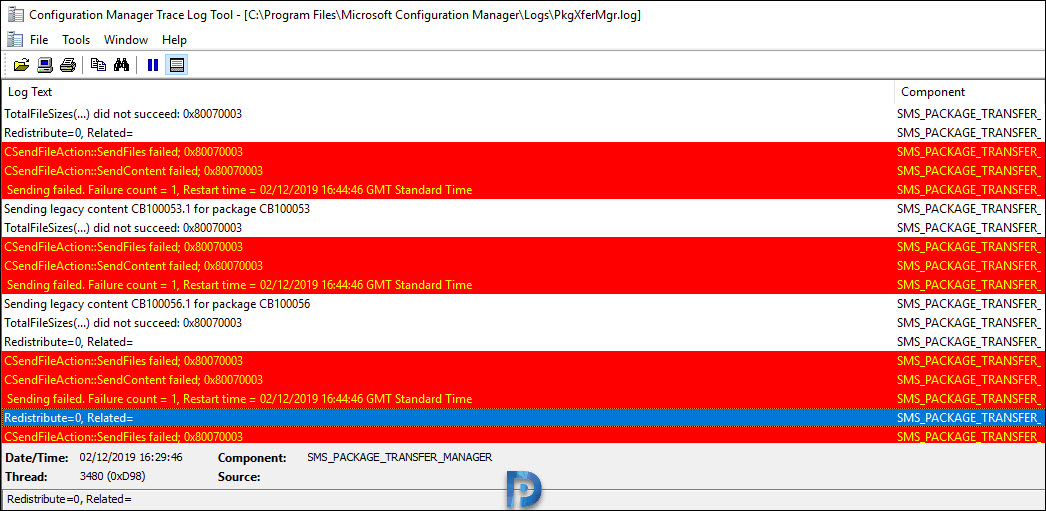I noticed a weird error in PkgXferMgr.log file during the SCCM content transfer – CSendFileAction::SendFiles failed; Error 0x80070003. In this post I will discuss about this error and at the end I will suggest some solutions.
Last week, on my prod setup, I installed Configuration Manager 1910 and started to install the required roles and configure other stuff. All the servers were installed with latest windows updates and installed with Sophos anti-virus.
On a new Windows 2019 server, I installed distribution point role and to my surprise it failed. Checking the distmgr.log file revealed an error which I fixed it quickly.
However when it came to distributing the content to distribution point, it failed. Even the Configuration Manager client package didn’t make it to distribution point.
Next, I decided to distribute an application instead of client package to the SCCM DP and the content was successfully distributed. At this point I had almost concluded that all the apps would successfully distribute but not the default packages.
So I decided to distribute two Windows 10 images, one was distributed and other failed with CSendFileAction::SendFiles failed; Error 0x80070003. I did not see any errors in distmgr.log file.
Package Transfer Manager failed to update the package "CB100053", Version 2 on distribution point MP server. Review PkgXferMgr.log for more information about this failure.Now the interesting thing is out of multiple packages distributed to the SCCM DP, some of them failed with Error 0x80070003. At this point I was sure that the issue is intermittent because not all content transfers were failing.
In addition to the above error, I visited the Monitoring > Overview > System Status > Component Status. I saw that SMS_DISTRIBUTION_MANAGER and SMS_PACKAGE_TRANSFER_MANAGER weren’t healthy. Below is the error that I found when I checked status message on SMS_PACKAGE_TRANSFER_MANAGER
Distribution Manager failed to process package "Configuration Manager Client Package" (package ID = CB100002).
Possible cause: Distribution Manager does not have access to either the package source directory or the distribution point.
Solution: Verify that distribution manager can access the package source directory/distribution point.I verified the permissions and yes the distribution manager had access to the package source. Here is how my PkgXferMgr.log looked.

TotalFileSizes(...) did not succeed: 0x80070003 SMS_PACKAGE_TRANSFER_MANAGER
CSendFileAction::SendFiles failed; 0x80070003 SMS_PACKAGE_TRANSFER_MANAGER
CSendFileAction::SendContent failed; 0x80070003 SMS_PACKAGE_TRANSFER_MANAGER
Sending failed. Failure count = 1, SMS_PACKAGE_TRANSFER_MANAGERSCCM Content Transfer Error 0x80070003
During the SCCM content transfer, if you are seeing the same Error 0x80070003 in PkgXferMgr.log, let me provide some solutions to fix this error.
- Try removing the distributed content from the distribution point and re-distribute the content.
- Check with your network team if there are any WAN accelerators or network appliances. Usually these interfere with network traffic and cause issues while distributing content.
- Some forum threads suggest to check the network access account. However the NAA is not related to this issue and it has nothing to do with the content transfer to DP’s.
- Finally the last and most important point – The antivirus or security software. In most cases the antivirus software is the main cause for content distribution failures. Hence always ensure your AV is not blocking the content distribution.
In my case it was Sophos agent that was causing the issues. The content distributed successfully after I disabled the Sophos AV on the SCCM distribution point and management point server. I am sure the Sophos AV exclusion policy was applied but seems like I need to review the policy once again.
The solution here is not to disable your antivirus, rather, define and apply an exclusion policy and ensure the AV doesn’t interfere in the content distribution. Read this article for antivirus exclusions for Configuration Manager current branch site servers, site systems, and clients.












